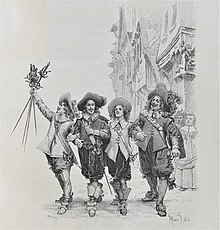Costume film
A costume film or equipment film is a film that is characterized by above-average production values for decorations, buildings, costumes and props.
history
Equipment and costume films mostly take place in epochs of the past that are commonly associated with pomp and display of splendor based on class and hierarchy, for example in ancient Rome or in the absolutist states of the 17th and 18th centuries. You can as historical films in their design closely historically founded facts and circumstances hold (about the films Sense and Sensibility , 1995 or Barry Lyndon , 1975), or free with the expectations of the audience get around and historical worlds of illusion to the taste create (about the Sissi trilogy, 1955 to 1957). As such, costume films often cross the line to become a pure product of illusion, detached from historical fidelity, for example in adventure films or fantasy films . However, the equipment and costume film is not tied to bygone times; there are examples like Star Wars (1977) or Flash Gordon (1980), which are at home in the science fiction genre .
Popular motifs in the set and costume films are opulently staged war battles ( War and Peace , 1956 or Cyrano von Bergerac , 1989) or scenes of courtly and social life such as balls ( Gone with the Wind , 1939 or The Leopard , 1963). Equipment and costume films are often intended to underline the dominant position of individual film studios and, in marketing, carry the effort made to the outside world, for example in advertising as the “most expensive film of all time”. For example, it has been suggested that Elizabeth Taylor's Cleopatra (1963) wardrobe cost $ 200,000. These large-scale productions also carry a high financial risk, as the example of the film Heaven's Gate (1980) shows, which brought Universal into great financial difficulties.
literature
- Peter Ettedgui : Film arts: production design (= rororo. Rororo non-fiction book. Rororo film + TV 60663). Rowohlt-Taschenbuch-Verlag, Reinbek near Hamburg 2001, ISBN 3-499-60663-1 .
- Fabienne Liptay , Matthias Bauer (ed.): Film genres. History and costume film. Philipp Reclam jun., Stuttgart 2013, ISBN 978-3-15-019064-7 .
- Fabienne Liptay (ed.): Milena Canonero (= Film Concepts Vol. 40). edition text + kritik, Munich 2015, ISBN 978-3-86916-448-9 .
Web links
- Costume films (Zeughauskino)
